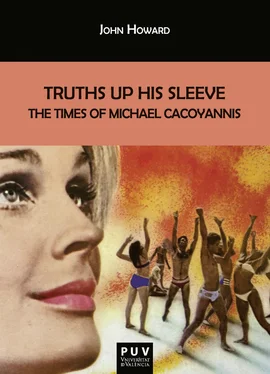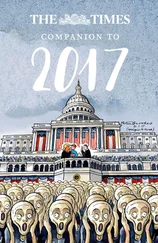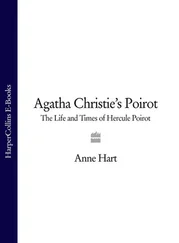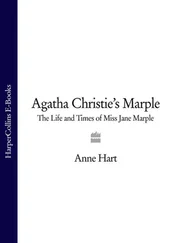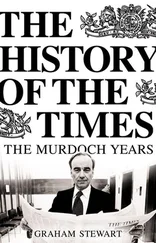1 ...6 7 8 10 11 12 ...19 Indeed, Michael’s “first signs of artistic talent” emerged around dance. Back in town, twin aunts Cleo and Athena served as big sisters to Stella and Michael, taking them along to ballroom classes with dance master Little Cyrus, “who had taught two generations of Limmasolians to dance…. Michael excelled[,] showing a rare sense of rhythm and an ear for music. Not content with the conventional steps, he was prolific in inventing new ones.” At Platres, these bold moves came in handy, as did Michael’s flare for theatricals. “As soon as Michael was old enough he organized us into a theatre company,” Stella remembered. “He wrote the plays, the shows and the songs, he arranged the choreography, designed and made the costumes and sets, acted the leading roles and directed.” At first, “only the family took part [including] a distant cousin” Michael had “tested and pronounced worthy of us. The audience were the children of the neighbourhood to whom we issued numbered tickets. To immortalise our artistic achievements we published a weekly magazine containing Michael’s plays, shorts stories, and poems,” along with “cartoons and puzzles of our own invention.” At Platres, new opportunities arose, with larger, more diverse audiences. 32
After the turn of the century Cypriot bards—“who travelled from city to city singing their epic poems” of tragedy—live music and live theatre performances were all too infrequent for Michael. “With the exception of a rare theatre troupe from Greece, the only live performances at that time in Cyprus were the cabaret shows,” which in Limassol included weekend matinee performances for children. Spaniards and Hungarians were prominent among these cabaret vocalists, as well as Greek singers such as Kakia Mendri and Sofia Vembo. Michael so admired contralto Vembo that he later would cast her in a film. Just as foreign visitors to Platres inspired speculation and intrigue, so too in Limassol did cabaret “artistes” from abroad. “Even as children we knew that the main function of the artistes was the ‘consummation.’” Some artists were steadily “engagee’’ with town bachelors, others with married men. Indeed, during summer, as wives and children “enjoyed the coolness of Platres, the men relieved their loneliness with the artistes”— whether female or male, as we see in Chapter 9. “In a society [of] decorum, where young men and women were not allowed to mix unchaperoned,” the cabaret functioned as a “permissive” space, with alternative norms and limits. A cabaret artist “accompanied by her mother” was assumed “an inaccessible virgin. This provoked heavy competition among the young men for her conquest.” Trans artists likewise inspired admiration, but more discreet competition among suitors. Cabaret artist Argentino, for example, performed “Spanish dances [cross]dressed as a woman, ending the show by taking off his wig to reveal his short hair.” Hardly surprising for most cabaret audience members, especially those who traveled to continental Europe, trans performers in Cyprus called up the transgressive politicized cabaret of interwar France and Weimar Germany. 33
Above even cabaret, above all, “the cinema dominated our lives. It was by far our favorite entertainment.” According to Stella, “we saw films of all nationalities: French, American, English, German, Greek,” notably omitting Turkish, a lifelong bias. Much anticipated and long remembered by Stella and Michael, the first pre-talkie sound on disc film in Limassol was The Bohemian Girl from 1927. Its new technology was “announced by printed handouts distributed at the cinema and pushed under front doors” of homes. It also was “advertised by the town crier riding through the streets in a gharry,” or horse-drawn carriage. “The whole of Limassol was at the cinema” for its debut. From the youngest age, Stella recalled, Michael had “a passion for the cinema. He knew the name of every actor and every film; he could describe every detail and sing every song in any language. He collected photographs and postcards of film stars and arranged them in albums” or pinned them to his bedroom wall. “He also read everything he could find about the cinema and the theatre.” Of German silent movies, Michael likely missed the groundbreaking 1919 Magnus Hirschfeld gay feature Different from the Others , released before his birth. But Michael doubtless saw or at least read about the 1924 Carl Theodor Dreyer “homosexual love story” based on the relationship between sculptor Auguste Rodin and a male model. Released in English translation from late 1926 under various titles, it came to be known foremost as Michael , making a profound impression on young Mihalis. In Cyprus, the dangerous new influence of film threatened the authority not only of parents but also schools, which attempted to delimit movie-going. In Limassol, the Greek Gymnasium forbade its students from attending “except on fixed days [to] selected films”—an early lesson in age-appropriate content if not censorship. Ever resourceful, Michael developed yet another method of sneaky peaking, after his family moved out of the Otto and Amalia Street duplex and he lost his balcony view of the open-air cinema screen. He “discovered that by climbing on a table and chair … at a friend’s house opposite the Yiordamlis Cinema, he could see a small section of the screen,” through the window and through the projection room. 34
In addition to a love of reading and movie-going, Stella and Michael shared an intense interest in other people and other ways of living, from sex workers to intersex businesspeople. In Limassol, sisters “Marika and Panayota [were] known as hermaphrodites,” or intersex. Tall and “thickset with deep voices” but smooth skin, they always wore “a black skirt [but with] a black coat exactly like a man’s. Their stockings were black and they wore men’s shoes…. Capable and respected business women [in] wholesale trade[,] they also ran a khani, a kind of boarding house for farmers and others from surrounding villages.” As precocious Stella and Michael witnessed, “Marika and Panayota sat in the cafes in the Central Market Square and drank coffee with the men. Though they were different,” they were neither feared nor shunned. Whereas Stella claimed townsfolk were “not particularly preoccupied with their sexual status,” Michael doubtless was. At minimum, he noticed a fundamental paradox. Picked out as different, they were not picked on, as he sometimes was. Their economic rank and bold self-acceptance shielded them. If local physicians or nurses perhaps had broken their confidentiality, the sisters would refuse shame or self-pity—as would most local sex workers. Sex work in Limassol was connected to the movies both conceptually and spatially, on-and off-screen, at Heroes Square. Yes, films depicted or suggested sex work, as with Morocco ’s audacious finale. But filmgoers furthermore mingled with sex workers. Not solely “the prostitutes’ domain,” Heroes Square also was home to “the best cinema in town.” So Michael and Stella “often passed the houses” of sex workers. “Front doors were always open, the beds clean and tidy.” Related, another house in Heroes Square bore a red cross with sign reading “Prophylactic Station.” It was “an annex to the V.D. clinic of the Government Hospital.” Thus, from as young as six, Michael and Stella “could recognize professional prostitutes,” who were characterized by “short tight dresses, flashy colours, high heels, long earrings[,] a painted face, dyed hair or gold teeth.” Also, when walking, they would “swing” their “behinds.” Or, prostitution took subtler forms. “A modest house in our neighbourhood excited our interest. Two young women lived in it and took in ironing. Somehow, we knew that their hobby”—or side hustle—“was prostitution.” In a similar manner, Stella and Michael learned about women’s reproductive health, about safe and unsafe methods of abortion, from the family cook. In these and countless other ways, close observation and empathetic attention—to and from women—supplemented “cinema [as] our main source of knowledge.” 35
Читать дальше
